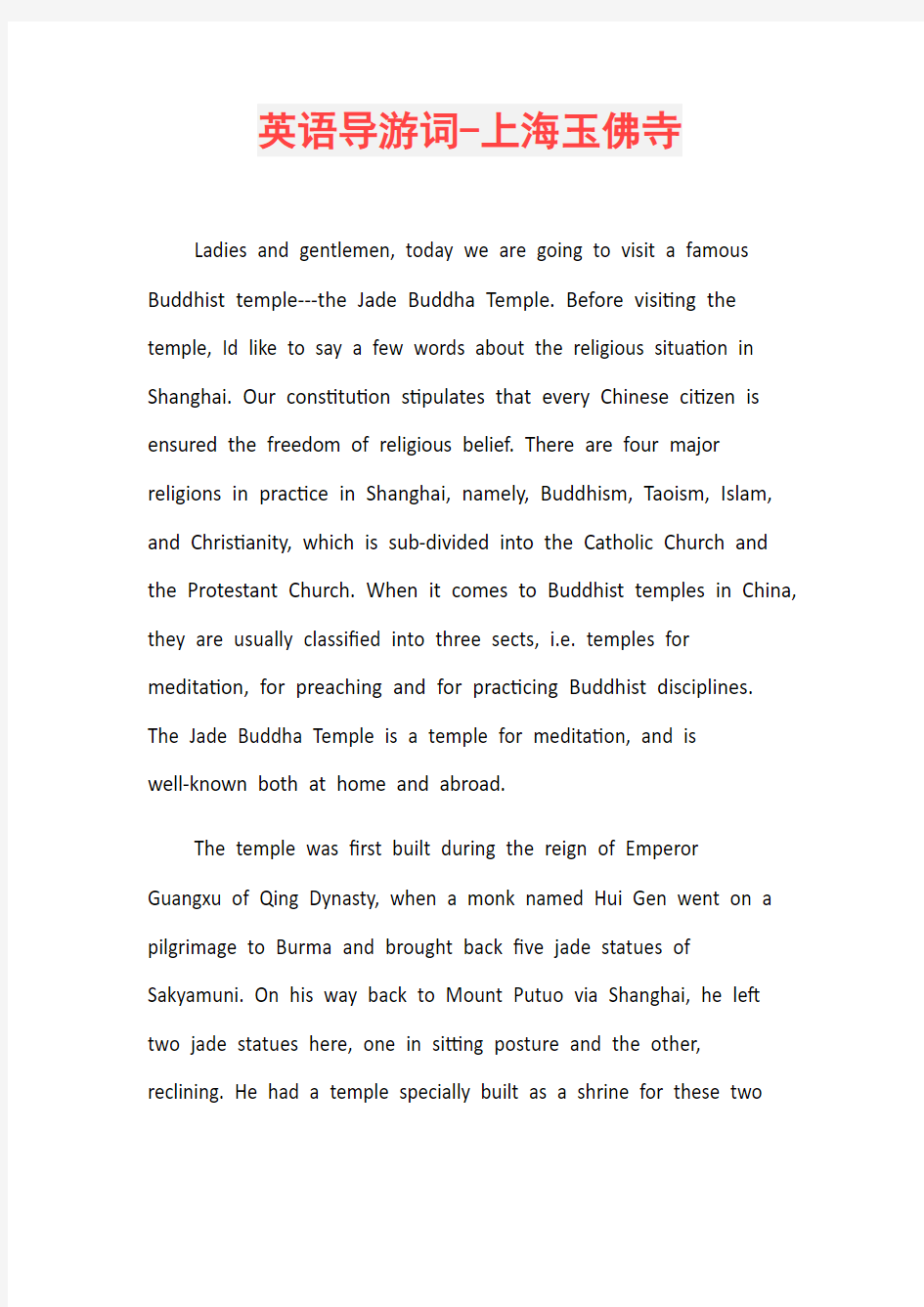英语导游词-上海玉佛寺


英语导游词-上海玉佛寺
Ladies and gentlemen, today we are going to visit a famous Buddhist temple---the Jade Buddha Temple. Before visiting the temple, Id like to say a few words about the religious situation in Shanghai. Our constitution stipulates that every Chinese citizen is ensured the freedom of religious belief. There are four major religions in practice in Shanghai, namely, Buddhism, Taoism, Islam, and Christianity, which is sub-divided into the Catholic Church and the Protestant Church. When it comes to Buddhist temples in China, they are usually classified into three sects, i.e. temples for meditation, for preaching and for practicing Buddhist disciplines. The Jade Buddha Temple is a temple for meditation, and is
well-known both at home and abroad.
The temple was first built during the reign of Emperor Guangxu of Qing Dynasty, when a monk named Hui Gen went on a pilgrimage to Burma and brought back five jade statues of Sakyamuni. On his way back to Mount Putuo via Shanghai, he left two jade statues here, one in sitting posture and the other, reclining. He had a temple specially built as a shrine for these two
statues in 1882. later the temple was partly destroyed by fire and in 1928 a new temple was completed on the present site.
Just opposite the temple gate, there stands a giant screen wall. Various designs, such as dragon, phoenix, elephant, crane and peony are carved on it. In Chinese legend, all these things are considered the symbols of fortune, wealth, longevity and auspiciousness. Chinese people used to set up a wall in front of the house so as to keep the evils away.
Now ladies and gentlemen, please turn around. Here we can see the temple gate. It is also called the Sanmen Gate, or say, the Gate of Three Extrications. The door in the middle is called the Door of Emptiness, to its right is the Door of Non-phenomenon, and to its left, the Door of Non-Action. Sanmen Gate is also called the Mountain Gate because most famous temples in China are found deep in mountains. But the Sanmen gate does not open except on the first and the fifteenth of every lunar month. Now this way to the entrance.
Ladies and gentlemen, the first hall is the Heavenly King Hall. We will use the rear door, please follow me.
(in the Heavenly King Hall next to the southern entrance)
Here we can find the statue of a fat and smiling monk with bared belly. He is Bodhisattva Maitreya. His smile is so contagious that you will smile with him and forget all your worries. So he is also called the Laughing Buddha. According to Buddhist scripture, he is now practicing Buddhism in the Tusita Heaven. After 4000 years, which is equal to 5.67 billion years on the earth, he will become successor to Sakyamuni under a Long Hua Tree in Hualin Garden. Hence another name the Future Buddha. But this statue we see here is not the real image of Bodhisattva Maitreya, it is just his incarnation.. it is said that During the Five Dynasties Period, 1000 years ago, there lived in Fenhua in Zhejiang Province a monk named Qi Ci, who always carried a wooden staff with a cloth sack on his shoulder. He often went around towns and in streets to beg alms. Therefore he became known as “the Cloth Sack Monk”. He always smiled and laughed, looking as happy as ever. When he was dying, he left the message saying that he was the incarnation of Bodhisattva Maitreya. So his image is enshrined in the Buddhist Temple as the incarnation of Bodhisattva Maitreya.
(on the eastern side of the Heavenly King Hall)
On the two sides of the hall are enshrined four statues. They are so-called Four Heavenly Kings. In the Buddhist legend, there is
in the center of the world a highest mountain called Mount Sumeru. Halfway on it is a mountain called Mount Ghandara with four peaks. On each peak lives a Heavenly King protecting the Buddhist heaven. The first one is the Southern King---King of Developing Merits. His duty is to educate all living creatures and develop king-heartedness. He is holding a sword in his hand which can emit a ray to chop off the enemies heads. The one next to him is the Eastern King---King
of Protection for Buddhism. He is holding in his hand a pipa, which is somewhat like a guitar. With this pipa, he offers music to the Buddha. Meanwhile this pipa is a magic weapon. It can send out a musical rhythm to defeat the enemy by tormenting brain and causing him to lose combatability. Now ladies and gentlemen, please come over to this side.
(on the western side of the Heavenly King Hall)
The first one on this side is the Northern King---King of Virtue. He is so called because of his virtue. He is holding a parasol-shaped stela in his hand. The parasol can be opened into a canopy in Buddhist processions. It is at the same time a magic umbrella. Once it is opened in the battle field, the sky turns dark and a wind-storm rises, defeating the enemy with a dizzy spell and then it closes up capturing all the enemies. Next to him is the Western King---King of
